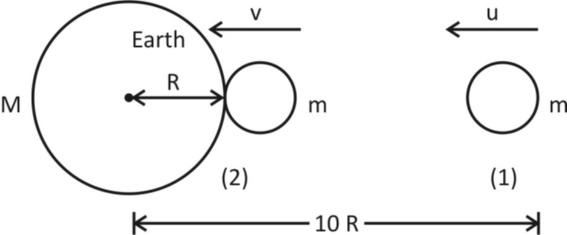
An asteroid is moving directly towards the centre of the earth. When at a distance of $10$R (R is the radius of the earth) from the earth centre, it has a speed of $12$km/s. Neglecting the effect on the earth's atmosphere, what will be the speed of the asteroid when it hits the surface of the earth (escape velocity from the earth is $11.2$km/s)? Give your answer to the nearest integer in Kilometre/s_ _ _ _ _ _
Answer
565.5k+ views
Hint: As the asteroid is moving towards earth, then by conservation by mechanical energy, the total energy at a distance $10R$ from the centre of earth will be the same as the total energy at distance R from the centre of earth.
Formula used:
1. Initial Mechanical Energy $ = $ Final Mechanical Energy
2. $K.E = \dfrac{1}{2}m{v^2}$
3. Potential Energy $ = \dfrac{{ - GMm}}{R}$
Complete step by step answer:
Let the velocity of asteroid at distance $10R$ from centre of Earth by, $u = 12km/s$ and the final velocity of asteroid at a distance R from the centre of earth be v km/s as shown in figure below:

Now, initial Mechanical Energy $ = $ Initial kinetic energy $ + $ initial potential energy
$ = \dfrac{1}{2}m{u^2} + \left( {\dfrac{{ - GMm}}{{10R}}} \right)$
And Final Mechanical energy $ = $ Final kinetic energy $ + $ initial potential energy
$ = \dfrac{1}{2}m{u^2} + \left( {\dfrac{{ - GMm}}{{10R}}} \right)$
Where M is mass of Earth
m is mass of asteroid
R is radius of earth and
G is universal Gravitational constant
So, by conservation of mechanical energy, initial mechanical energy $ = $ final mechanical energy
$ \Rightarrow \dfrac{1}{2}m{u^2} + \left( {\dfrac{{ - GMm}}{{10R}}} \right) = \dfrac{1}{2}m{v^2} + \left( {\dfrac{{ - GMm}}{R}} \right)$
$ \Rightarrow \dfrac{1}{2}m{v^2} - \dfrac{1}{2}m{u^2} = \dfrac{{ - GMm}}{{10R}} + \dfrac{{ - GMm}}{R}$
$ \Rightarrow \dfrac{1}{2}\left( {{v^2} - {u^2}} \right) = \dfrac{{ - GMm}}{R}\left( {\dfrac{1}{{10}} - 1} \right)$
$ \Rightarrow \dfrac{1}{2}\left( {{v^2} - {u^2}} \right) = \dfrac{{ - GM}}{R} \times \dfrac{{ - 9}}{{10}}$
$ \Rightarrow {v^2} - {u^2} = \dfrac{{9GM}}{{10R}} \times 2$
$ \Rightarrow {v^2} = {u^2} + \dfrac{{9GM}}{{5R}}........\left( 1 \right)$
Now, here $u = 12km/s = 12000m/s$
M$ = $ mass of earth
As $\dfrac{{GM}}{{{R^2}}} = g \Rightarrow \dfrac{{GM}}{R} = gR$
So, \[{v^2} = {u^2} + \dfrac{9}{5}gR\]
\[\Rightarrow {v^2} = {\left( {12000} \right)^2} + \dfrac{9}{5} \times 9.8 \times 6400000\]
\[\Rightarrow {v^2} = 14000000 + 112896000\]
\[\Rightarrow {v^2} = 256,896,000\]
\[\Rightarrow v = 16,027.97m/s\]
$\Rightarrow v \simeq 16km/s$
Note:
The relation between acceleration due to gravity, g and universal gravitational constant, G is
$g = \dfrac{{GM}}{{{R^2}}} \Rightarrow \dfrac{{GM}}{R} = gR$
So, we have replaced $\dfrac{{GM}}{R}$ with gR in equation ....(1).
Formula used:
1. Initial Mechanical Energy $ = $ Final Mechanical Energy
2. $K.E = \dfrac{1}{2}m{v^2}$
3. Potential Energy $ = \dfrac{{ - GMm}}{R}$
Complete step by step answer:
Let the velocity of asteroid at distance $10R$ from centre of Earth by, $u = 12km/s$ and the final velocity of asteroid at a distance R from the centre of earth be v km/s as shown in figure below:

Now, initial Mechanical Energy $ = $ Initial kinetic energy $ + $ initial potential energy
$ = \dfrac{1}{2}m{u^2} + \left( {\dfrac{{ - GMm}}{{10R}}} \right)$
And Final Mechanical energy $ = $ Final kinetic energy $ + $ initial potential energy
$ = \dfrac{1}{2}m{u^2} + \left( {\dfrac{{ - GMm}}{{10R}}} \right)$
Where M is mass of Earth
m is mass of asteroid
R is radius of earth and
G is universal Gravitational constant
So, by conservation of mechanical energy, initial mechanical energy $ = $ final mechanical energy
$ \Rightarrow \dfrac{1}{2}m{u^2} + \left( {\dfrac{{ - GMm}}{{10R}}} \right) = \dfrac{1}{2}m{v^2} + \left( {\dfrac{{ - GMm}}{R}} \right)$
$ \Rightarrow \dfrac{1}{2}m{v^2} - \dfrac{1}{2}m{u^2} = \dfrac{{ - GMm}}{{10R}} + \dfrac{{ - GMm}}{R}$
$ \Rightarrow \dfrac{1}{2}\left( {{v^2} - {u^2}} \right) = \dfrac{{ - GMm}}{R}\left( {\dfrac{1}{{10}} - 1} \right)$
$ \Rightarrow \dfrac{1}{2}\left( {{v^2} - {u^2}} \right) = \dfrac{{ - GM}}{R} \times \dfrac{{ - 9}}{{10}}$
$ \Rightarrow {v^2} - {u^2} = \dfrac{{9GM}}{{10R}} \times 2$
$ \Rightarrow {v^2} = {u^2} + \dfrac{{9GM}}{{5R}}........\left( 1 \right)$
Now, here $u = 12km/s = 12000m/s$
M$ = $ mass of earth
As $\dfrac{{GM}}{{{R^2}}} = g \Rightarrow \dfrac{{GM}}{R} = gR$
So, \[{v^2} = {u^2} + \dfrac{9}{5}gR\]
\[\Rightarrow {v^2} = {\left( {12000} \right)^2} + \dfrac{9}{5} \times 9.8 \times 6400000\]
\[\Rightarrow {v^2} = 14000000 + 112896000\]
\[\Rightarrow {v^2} = 256,896,000\]
\[\Rightarrow v = 16,027.97m/s\]
$\Rightarrow v \simeq 16km/s$
Note:
The relation between acceleration due to gravity, g and universal gravitational constant, G is
$g = \dfrac{{GM}}{{{R^2}}} \Rightarrow \dfrac{{GM}}{R} = gR$
So, we have replaced $\dfrac{{GM}}{R}$ with gR in equation ....(1).
Recently Updated Pages
Why are manures considered better than fertilizers class 11 biology CBSE

Find the coordinates of the midpoint of the line segment class 11 maths CBSE

Distinguish between static friction limiting friction class 11 physics CBSE

The Chairman of the constituent Assembly was A Jawaharlal class 11 social science CBSE

The first National Commission on Labour NCL submitted class 11 social science CBSE

Number of all subshell of n + l 7 is A 4 B 5 C 6 D class 11 chemistry CBSE

Trending doubts
What is meant by exothermic and endothermic reactions class 11 chemistry CBSE

1 Quintal is equal to a 110 kg b 10 kg c 100kg d 1000 class 11 physics CBSE

What are Quantum numbers Explain the quantum number class 11 chemistry CBSE

What is periodicity class 11 chemistry CBSE

What is a periderm How does periderm formation take class 11 biology CBSE

Mention the basic forces in nature class 11 physics CBSE




